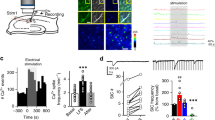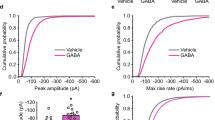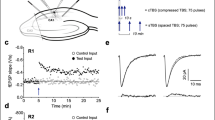Abstract
Bortolotto et al.1 report that the kainate subtype of glutamate receptor is essential for the plasticity of certain types of synaptic transmission in the brain, which is of interest as these receptors were previously not thought to initiate plastic processes. In particular, a new antagonist (LY382884) was shown to act selectively against the GluR5 type of kainate receptor: in the presence of LY382884, which reduces kainate-receptor-mediated postsynaptic responses by ∼40%, long-term potentiation (LTP) at hippocampal mossy-fibre synapses could no longer be induced1. Here we argue that the available evidence does not support a major role for kainate receptors in the induction of mossy-fibre LTP.
Similar content being viewed by others
Main
It is well established that kainate receptors are also blocked by the ionotropic glutamate-receptor antagonists kynurenate and CNQX, and therefore, if Bortolotto et al. are correct, mossy-fibre LTP should also be blocked by these antagonists. Although they do provide evidence that this is the case, their results contradict earlier work showing that these antagonists, at the same or higher concentrations, are ineffective on mossy-fibre LTP2,3,4,5,6.
In two of these studies2,3, 10–20 mM kynurenate was found to have no effect, whereas Bortolotto et al.1 report that 10 mM kynurenate blocks LTP completely (for reference, 1 mM kynurenate is sufficient to block the kainate-receptor-mediated excitatory postsynaptic current (e.p.s.c.)7). The others4,5,6 showed that 10–20 μM CNQX, which also blocks the kainate-receptor-mediated e.p.s.c. by 40–80% (ref. 8), did not prevent induction of mossy-fibre LTP. In two cases5,6, the entire experiment was done in the presence of 10 μM CNQX, the concentration used to block mossy-fibre LTP by Bortolotto et al.1, and the increase in glutamate release that underlies mossy-fibre LTP was monitored using the NMDA-receptor-mediated e.p.s.c.
By studying LTP on the NMDA-receptor component of the e.p.s.c., which has properties identical to the LTP of the AMPA-receptor component5,6, the potentiation can be assessed continuously after induction. We believe that this approach has better resolving power than the experiments of Bortolotto et al.1, where LTP is presumed to be blocked on the basis that no potentiation is apparent three hours after induction and washout of the antagonist. Evidence using glutamate-receptor antagonists2,3,4,5,6 would indicate that kainate receptors are not required for mossy-fibre LTP.
The results taken together suggest that the action of LY382884 on mossy-fibre LTP is either nonspecific or indirect. This is supported by expression data showing that the GluR5 subunit of kainate receptors is only weakly expressed in the dentate gyrus and in area CA3 of the hippocampus9,10, and that most (about 90%) of the cells generating this weak signal are GABAergic interneurons10, thought not to be directly involved in the induction of mossy-fibre LTP.
Given these combined results2,3,4,5,6,9,10, we believe that GluR5 is unlikely to play a role in mossy-fibre synaptic transmission or plasticity; although LY382884 may antagonize GluR5-containing kainate receptors, its effect on mossy-fibre LTP is more likely to involve some other interaction of this drug with synaptic transmission.
References
Bortolotto, Z. A. et al. Nature 402, 297–301 (1999).
Castillo, P. E., Weisskopf, M. G. & Nicoll, R. A. Neuron 12, 261– 269 (1994).
Yeckel, M. F., Kapur, A. & Johnston, D. Nature Neurosci. 2, 625– 633 (1999).
Ito, I. & Sugiyama, H. NeuroReport 2, 333–336 (1991).
Weisskopf, M. G. & Nicoll, R. A. Nature 376, 256–259 (1995).
Tong, G., Malenka, R. C. & Nicoll, R. A. Neuron 16, 1147– 1157 (1996).
Castillo, P. E., Malenka, R. C. & Nicoll, R. A. Nature 388, 182– 186 (1997).
Vignes, M. & Collingridge, G. L. Nature 388, 179–182 (1997).
Bahn, S., Volk, B. & Wisden, W. J. Neurosci. 14, 5525– 5547 (1994).
Paternain, A. V., Herrera, M. T., Nieto, M. & Lerma, J. J. Neurosci. 20, 196–205 (2000).
Author information
Authors and Affiliations
Corresponding author
Rights and permissions
About this article
Cite this article
Nicoll, R., Mellor, J., Frerking, M. et al. Kainate receptors and synaptic plasticity . Nature 406, 957 (2000). https://doi.org/10.1038/35023075
Issue Date:
DOI: https://doi.org/10.1038/35023075
This article is cited by
-
Presynaptic kainate receptors impart an associative property to hippocampal mossy fiber long-term potentiation
Nature Neuroscience (2003)
-
Kainate receptor-mediated heterosynaptic facilitation in the amygdala
Nature Neuroscience (2001)
Comments
By submitting a comment you agree to abide by our Terms and Community Guidelines. If you find something abusive or that does not comply with our terms or guidelines please flag it as inappropriate.



